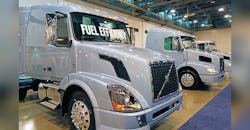For a number of years, Volvo Trucks engineers have been touting the potential of dimethyl ether (DME) as a good alternative to diesel. Now the truck builder is convinced that DME’s time has come.
“You can get it from a lot of sources—natural gas and biomass such as corn silage, agricultural silage, cow manure, chicken manure, leftover food waste,” Bill Hubbartt, vice-president of the Central Region for Volvo Trucks, said during the National Tank Truck Carriers Tank Truck Week, held October 28-30, 2013 in Houston, Texas. “This is science fiction stuff. If you had talked to people about this 15 years ago, they’d have said, ‘You’re crazy.’ ”
Back in June 2013, Volvo Trucks became the first manufacturer to announce plans to commercialize DME-powered heavy-duty commercial vehicles in North America. Sister company Mack Trucks also plans to sell DME-fueled trucks.
As the latest step in its “Blue Power” alternative fuel strategy, Volvo revealed its ongoing US customer field testing of trucks powered by DME, which mirrors the performance qualities and energy efficiency of diesel, and burns clean without producing any soot.
Converting natural gas to DME is a way to address many of the distribution, storage, and fueling challenges otherwise presented by natural gas as a heavy-truck fuel.
Volvo announced plans to begin limited production in 2015 of DME-powered vehicles and has been working in tandem with Oberon Fuels, the first company to announce plans to commercialize DME fuel production in North America.
Volvo’s DME technology will be available in a Volvo D13 engine, and the company’s I-Shift automated manual transmission will be standard on DME-powered trucks. DME-powered vehicles will join a line-up that already includes compressed natural gas (CNG)-powered Volvo VNM and VNL model daycabs. The company also will introduce its own proprietary liquefied natural gas (LNG)-fueled engine in VNL daycabs and sleepers this year.
The move to DME is part of Volvo’s strategy to pursue alternative fuels and reduce the carbon footprint of heavy-duty commercial trucks, according to Hubbartt.
“There’s no right or wrong in alternative fuels,” he said. “You need to think about this very seriously because the train has left the station. This is irreversible. Alternative fuels are going to be a part of your life. It’s just a fact.
“Is diesel going away? Absolutely not. Diesel will be here for the next 25 to 28 years. But you have to consider energy efficiencies and what’s right about your business model. We’ve been looking at alternative fuels since 2006. We’re looking at the full genre of alternative fuels.”
He said Volvo decided to invest in DME technology and introduce it to the North American market because of the numerous benefits DME offers as a heavy-truck fuel. Its high cetane number delivers performance and efficiency comparable to diesel, and it packages densely enough on a truck to support long-range transportation, or to allow room for vocational equipment on the frame.
Volvo believes it is an excellent compression ignition fuel which, like diesel, requires no separate ignition mechanism. Unlike LNG, it does not require cryogenic temperatures; it is handled and stored like propane, with tank pressures of only 75 psi (versus 3600 psi for CNG).
Because DME produces no soot, a diesel particulate filter (DPF) is not necessary. In addition to the weight savings from the removal of the DPF system, DME fuel tanks are considerably lighter than comparable CNG or LNG tanks and considerably less complex.
DME is non-toxic, and is already used as an aerosol propellant in cosmetics and other household products. It can be made from a variety of sustainable feedstocks, including biogas from food and animal waste, wastewater treatment facilities, and landfills. When produced from biomass or biogas, DME can provide up to 95% CO2 reduction compared to diesel.
Oberon Fuels has developed new skid-mounted, small-scale production units that can cost effectively convert biogas and natural gas into DME. The first of Oberon’s production units went online in June in California’s Imperial Valley region.
Hubbartt said some companies are installing their own DME dispensing plants.
“You can sign seven-year contract with gas companies and lock in fuel costs,” he said. “They’re controlling their destiny.”
Hubbartt said Nissan, Isuzu, and Weichai—an engine manufacturer in China—are “going in big time (on DME), and it’s not just trucks. They’re putting DME engines in bulldozers, city buses, taxi cabs, and cars. (Weichai is) betting the farm on it. There’s 100 years of natural gas in Mongolia and they’re building mega-refineries. They want to be energy-independent. They don’t want to have their oil crews in Nigeria. This is an avenue.”
DME produced from methanol has a price that is a function of the cost of methanol and LP-gas. DME’s energy value is 62% of LPG, and the listed sale price is typically 75% to 90% of LPG.
DME is a colorless, odorless, and tasteless compound that is non-toxic and non-carcinogenic. Its molecular formula is C2OH6, giving it behavioral properties similar to propane. Like LPG, DME is gaseous at ambient temperature and pressure, but changes to a liquid when subjected to modest pressure or cooling. This easy liquefaction makes DME easy to transport and store—usually in tanks similar to those used in the propane industry.
Hubbartt said the D13 is designed to meet current and future EPA regulations while improving reliability and lowering operating costs. Fourteen power ratings are available in the range from 375 to 500 hp.
The new variable geometry turbo makes the engine responsive while improving fuel economy. Two XE ratings, six Eco-Torque, and three Dual-Torque ratings provide “dual-personality” torque output for those customers who desire the high fuel economy of their lower torque levels with the strong performance of their higher outputs. ♦
About the Author
Rick Weber
Associate Editor
Rick Weber has been an associate editor for Trailer/Body Builders since February 2000. A national award-winning sportswriter, he covered the Miami Dolphins for the Fort Myers News-Press following service with publications in California and Australia. He is a graduate of Penn State University.
